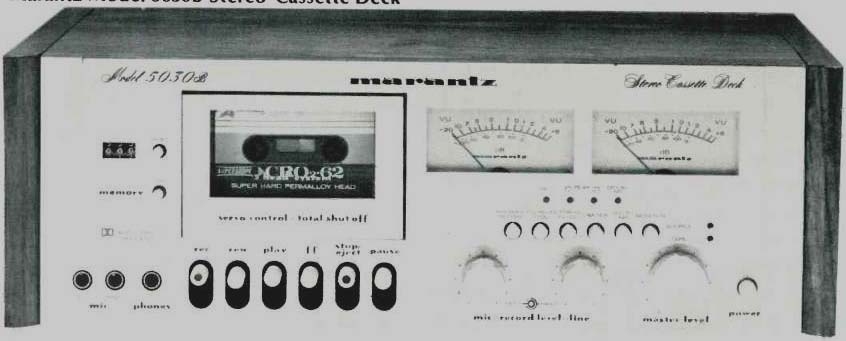
MANUFACTURER'S SPECIFICATIONS:
Frequency Response: 35 Hz to 14 kHz, 35 Hz to 17 kHz with FeCr or CrO2 tapes.
Signal-to-Noise Ratio: 58 dBA, 64 dBA with Dolby N/R. Input Sensitivity: Mike, 0.16 mV; Line, 50 mV. Output Level: Line, 800 mV; Headphone, 43 mV. Flutter: 0.05 percent W rms.
Wind Time: 105 seconds for C-60 cassette.
Dimensions: 17-3/8 in. (441 mm) W x 5-3/4 (146 mm) H x 11-11/16 (297 mm) D.
Weight: 14.8 lbs. (6.7 kg).
Price: $419.95.
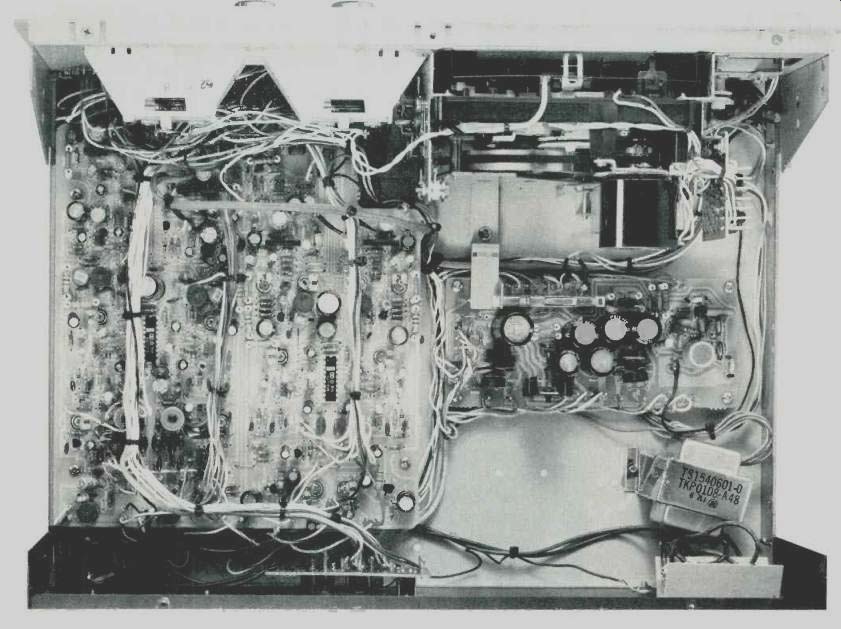
The Marantz 5030B cassette deck offers a true three-head design for a medium price. The record and playback heads are actually separate structures, but mounted within a single metal enclosure. A shielding board between the two heads minimizes cross feed. Access to the heads for cleaning and demagnetizing is quite good with the door cover removed (easily snapped out) and the unit in Play mode without a cassette. Loading and unloading is direct and was smooth in action. Medium force was required to actuate the tape motion levers, lighter than most units with this design. It was possible to go into Play from winding, but undesirable tape loops were formed when doing so. The tape counter includes the useful memory function. The meters have fluorescent scales, blue from-20 to-1 and red from 0 to +6, without any direct illumination. Below are the LED record and Dolby NR status lights and peak-level indicators for each channel, which offer some advantage over a single one for both channels. Three push-button switches select bias and EQ for low-noise, FeCr or CrO2 tapes. Similar switches provide on/off control for Dolby NR and a limiter, and monitor selection, source or tape, which has two associated status lights.
The input-level control facilities are superior to most decks with full mike and line mixing and an always-useful master level pot. The knobs on the mike and line dual-concentric pots are of good size and finely knurled. As the non-clutched knobs in each set are very close to the same diameter, both channels can be adjusted at the same time if desired. Mike input and headphone jacks are on the front panel, and line in and out phono jacks are on the rear panel. A ground post and a multiplex filter switch are also on the back panel, a location which may keep the switch position out of mind.
Accessory handles are available for rack mounting.
Soldering on the PCBs was excellent. The trimmed leads seemed a trifle long, but there were no danger spots, and troubleshooting would be facilitated. Wirewrap was used for inter-card wiring. Adjustments were labeled, and parts were identified. It was noted that higher wattage resistors were mounted on ceramic standoffs and that the rugged bottom and side construction of the chassis was well suited to rack mounting.
Performance
The playback responses with standard tapes were generally very smooth, but there was a dip of about 5 dB with the 63 Hz tone. Playback of standard levels gave indications about a dB low, and play speed was about 0.7 percent fast. Record/playback responses were best with Sony UHF, Sony FeCr, and TDK SA. Results were also good with other tapes with similar bias requirements, such as Ampex Grand Master, Audio Magnetics High Performance, Scotch Master IIIs, etc. Over the majority of the band, the responses 20 dB below Dolby level were very flat, with deviations of less than a dB with all three tapes. Also to be applauded were the very minor deviations when switching to Dolby mode, especially with TDK SA. High end limits in normal mode were 5.8, 3.1, and 6.3 kHz at Dolby level for Sony UHF, Sony FeCr and TDK SA, respectively. With the level 20 dB lower, roll-off was at 16.1, 20.3 and 19.5 kHz for the same tapes.
At 100 Hz and below, head contour effects were evident, especially with the broad dip around 60 Hz, almost 3 dB. deep. The-3 dB point was actually reached at 23 Hz in all cases, certainly very good. One hopes that future designs will show less deviation in this region. The playback of a recorded 10-kHz tone showed close to 70 degrees phase discrepancy between channels, indicative of the challenge of mounting head sections in perfect alignment. The phase jitter was just 20 degrees, the best ever measured on a cassette deck. The multiplex filter was down 26 dB at 19 kHz, 29.5 dB at 18.6 kHz. Bias was of low level in the output, whether switched to Source or Tape playback.
The relative level of third harmonic distortion was measured vs. record level from-10 dB (re: Dolby level) to the 3 percent distortion point. The plotted curves were unusual in two respects. First of all, amplitude compression appeared without the expected high rise in distortion, causing the curves to bend flatter rather than more sharply upward. The net result was that overload was more gradual than with other decks, particularly with Sony UHF. The other different-from-normal aspect was the lowest distortion performance with a chrome-type tape (TDK SA). Low-noise tapes have that distinction with most decks. On the other hand, TDK SA showed slightly higher HDL2 than the other two tapes. HDL5 was very low for all tapes at all record levels. HDL3 vs. frequency with TDK SA at 10 dB below Dolby level was low over most of the range, but on the high side around 5 kHz.
The use of Dolby reduced distortion products for all tapes at all levels across the entire frequency band, much better results than with most decks.
The signal-to-noise ratios at Dolby level were 54.1, 58.4 and 57.4 dBA for Sony UHF, Sony FeCr, and TDK SA, respectively.
With a record level to cause HDL3 = 3 percent, the results' were 58.1, 60.8 and 60.4 dBA for the same tapes. With Dolby mode and HDL3 = 3 percent, the figures were 66.5, 68.0 and 68.0 dBA for the same order. On a CCIR/ARM basis, the ratios for Sony UHF, Sony FeCr and TDK SA at HDL3 = 3 percent were 55.1, 58.5 and 57.7 dB respectively, and 65.2, 68.6 and 67.8 dB with Dolby, for the same order. All in all, excellent performance, especially in light of the amplitude compression noted earlier. Erasure and crosstalk were both more than 80 dB down, and separation was 46 dB, better than many decks.
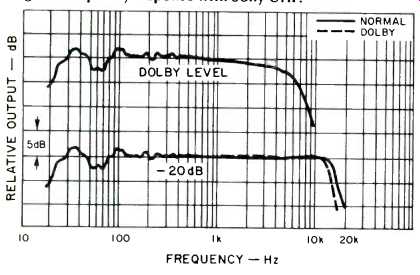
Fig. 1--Frequency response with Sony UHF.
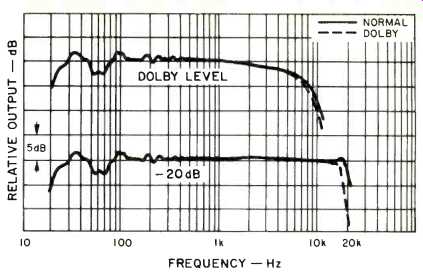
Fig. 2--Frequency response with TDK SA.
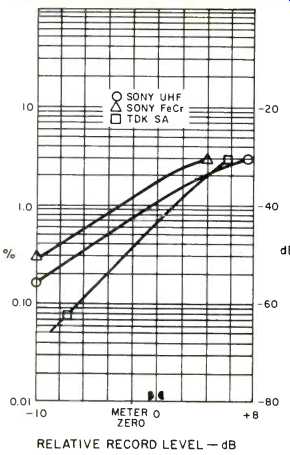
Fig. 3--Percentage of third harmonic distortion vs. 1-kHz record level with
Sony UHF, Sony FeCr, and TDK SA.

Action of the 5030's limiter.
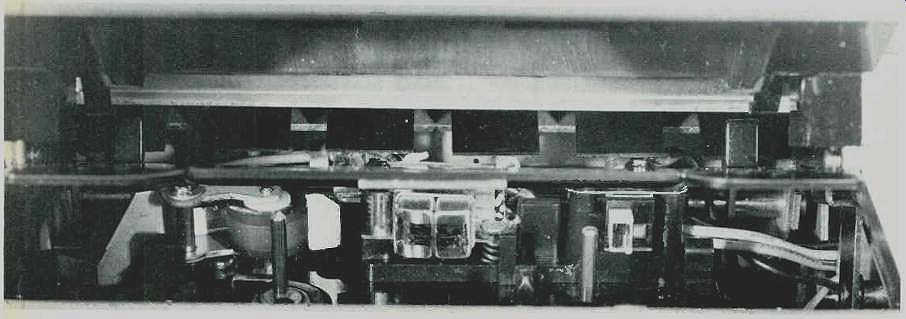
Mike input sensitivity was 0.19 mV, and input overload was at 60 mV. Line sensitivity was 71 mV, higher than the spec, and overload was at 4.0 volts. Output clipping appeared at a level equivalent to a meter indication of +15. The master input level pot sections tracked within a dB down 55 dB from maximum setting. The mike and line level pots also tracked very well. The line output levels were 640 mV at meter zero, 770 mV at Dolby reference (+2 meter). The headphone output was 39 mV with 8-ohm loading, a little under the specified 43 mV, but more than adequate for all the phones tried.
In fact, the lack of an output pot made the use of sensitive phones impossible because of the high levels. The frequency response of the level meters met VU standards, but the action was a little sluggish, getting to just-2 with the standard 300-mS burst. The meters read high with below zero input levels and read low with above zero signals, but with adequate accuracy. The peak indicator thresholds were at +3 with a 1-kHz CW input. They were still turning on with a tone burst that was just one cycle of 1 kHz, excellent response. The limiter threshold was at a somewhat low-2 on the meters. Even very high-level signals were reduced to meter zero, perhaps more than necessary. A 140-mS burst with a CW level 15 dB above meter zero was limited to +2 even at the very start of the burst, with reduction in level to +1/2 by the end of the burst.
Tape speed was plotted with changes in line power with a 120-V reference. Increases in line voltage on playback caused more of a change in tape speed, but the variation was less than 0.2 percent. Flutter plot were made to both W rms and weighted peak standards. In each case, the recorder was started three different times after tape-motion switching and re-entering play mode. The flutter performance was consistent with typical values of 0.05 percent W rms and 0.08 percent wtd pk, meeting its tight specification. The average wind time was 97 seconds, within spec, but a little on the slow side.
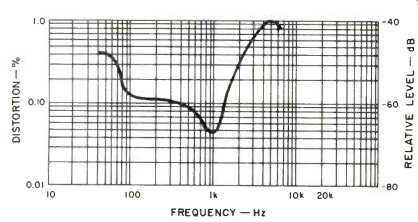
Fig. 4--Level of third harmonic distortion vs. frequency at 10 dB below Dolby
level using TDK SA.
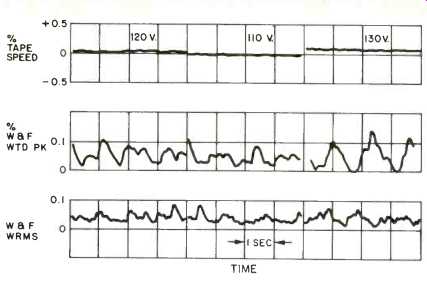
Fig. 5--Tape speed vs. line voltage and flutter.
In-Use Tests
Cassette loading and unloading and head cleaning were all easy tasks. The medium pressure required to actuate the tape-motion levers was much lower than many decks with the same approach. The combination of input pots, including the master, and the excellent peak indicators facilitated setting and adjusting levels. Meter action appeared to be acceptable, although tests had shown it a bit sluggish according to the standard. The fluorescent scales seemed attractive, but were a little difficult to use with low-level illumination.
The lack of an output pot made Normal/Tape Play matching impossible in the evaluation monitor system.
The instruction book is very well written with pertinent and lucid comments and excellent illustrations. There is no list of recommended tapes, which may be better than listing many that wouldn't be that good a match. This reviewer, however, encourages manufacturers to let the consumer in on what tapes are used to set the machine up. Alternatively, a statement on the bias provided at various settings would be a guide.
For the great majority of the sources copied and played back, there was nothing to fault in reproduction. Switches between normal and Dolby generated no detectable changes except for the lower noise in Dolby. With its three-head system, the Marantz 5030B could be checked easily and quickly for any form of overload during the record process. With just one source with a lot of bass, there was some evidence of a change in the playback, judged to be from the dip around 60 Hz. All record, pause, and stop clicks were down at tape noise level, with the exception that the latter stood out a bit in Dolby mode, with its lower noise level. The Marantz cassette deck has a few minor limitations: the lack of an output pot was the most important to me. On the plus side, the 5030B offers tape playback while recording, very flat response over most of the audio range, high signal-to-noise ratios, excellent input mixing/level control, low flutter and phase jitter, and a good limiter.
-Howard A. Roberson
(Source: Audio magazine, Dec. 1978)
Also see: Aiwa Model AD-6550 Stereo Cassette Deck (Dec. 1978)
Marantz Model 2500 Stereo FM/AM Receiver (Feb. 1978)
Nakamichi BX-300 Cassette Deck (Nov. 1984)
= = = =